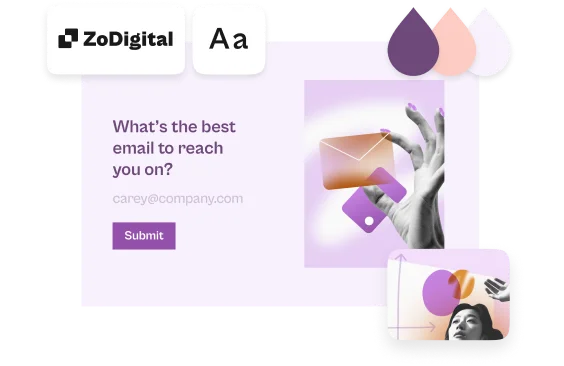Validate a respondent’s email address (workaround)
Make sure the data you collect is reliable, and reduce the chances of receiving incorrect or fake email addresses with this workaround to validate respondents’ email addresses.
While Typeform ensures that email addresses are correctly formatted (e.g., xxxx@yyy.zzz), there’s currently no built-in solution to verify that a respondent owns the email address they provide.
However, by creating 2 forms–we’ll refer to them as form A and form B in this article–and using Follow-ups and Hidden Fields, we can set up a workaround so respondents have to validate their email address before answering the rest of your questions.
- Form A collects your respondents’ email addresses and any other personal information you need.
- Form B contains the rest of your questions–respondents can only access this form after receiving the Follow-up email and validating their email address.
We’ve seen this flow work well to validate email addresses before respondents get access to gated content or prizes, and for event registration.
However, the suitability of this workaround will depend on your individual use case. It’s important to note that if people get hold of your link to form B, they’ll be able to fill in the form without verifying their email address.
Ready to dive in? Choose between a quick summary of the process or a step-by-step guide:
- Quick summary on how to set up email validation
- Step-by-step guide on how to set up email validation
Quick summary on how to set up email validation
1. Create a form asking for your respondent's email address and any other contact information you want to capture.
2. Use Follow-ups and Hidden Fields to send an email notification to the email address your respondent provides, linking them to a second form.
3. The second form should include Hidden Fields, recalling their contact information from the first form.
4. Now, you’ll know that any responses you receive to the second form are coming from a verified email address.
Step-by-step guide on how to set up email validation
Create 2 forms
- Form A: This form collects the respondent's email address and any other personal information you need. In our example, we’re creating an event sign-up form and we’ve asked our respondents for their name and email address. We’ve made both questions required.
We’ve also added an End Screen to Form A asking our respondents to check their email inbox to validate their email address before they can continue with the signup process.
- Form B: This form contains the rest of your questions. The respondent will only get the link to this form when they’ve received a Follow-up email that validates their email address.
When you’re happy with how your forms look, make sure to click Publish to make them live.
Just getting started with Typeform? Check out this article for help creating your first form.
Add Hidden Fields
1. In form B, click the Logic tab in the right sidebar and choose Personalize with data.
2. Click Hidden Fields.
3. Choose what data you want to pass from form A to form B. In our example, we’ll choose email and name.
4. Click Save.
5. Click Publish to make your changes live.
6. Click Copy link to grab your form’s link (the Hidden Fields have been added to the end of the URL).
Learn more about Hidden Fields here.
Add a follow-up
7. Back in form A, click the Settings icon and choose Follow-ups.
8. Click Create a follow-up.
9. Click Add trigger.
10. Decide what will trigger this follow-up. In our example, we want anyone who fills in our form to receive a follow-up email to the address they provided in the form, so we’ll choose Any response and click Save.
Learn more about follow-ups here.
11. Next, we'll click Add action...
12. ...And choose Send email to respondents.
13. Make sure the information about who will receive the email and where replies will be sent is correct, and then click Continue.
14. Edit the email subject line to make it specific to your use case. In our example, we’ll thank respondents for verifying their email address.
15. In the Email content section, we’ll ask our respondents to finish the registration process by clicking the link. We’ll use Recall information to make things more personal by greeting our respondents by name.
16. To add the link to form B and replace the placeholder xxxxxs in the Hidden Fields with the correct information, we’ll highlight “click here” and choose the link icon.
17. We’ll paste our form B link, and replace the xxxxxs with the information our respondent added to form A, by typing an @ symbol and choosing the email and name question.
18. Click Save when you're happy with how things look.
19. Now, when a respondent fills out their email in form A, they’ll be sent an email to the address they entered with a link to form B.
20. The name and email address that respondents enter in form A will be pulled through to the Responses section of the Results panel in form B from the Hidden Fields. This way, respondents won’t need to enter their details again, and we’ll know that they own the email address they provided in form A.


